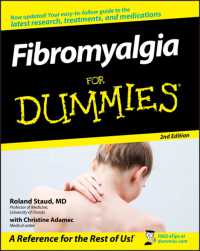- ホーム
- > 洋書
- > 英文書
- > Science / Mathematics
Full Description
As researchers have pursued biology's secrets to the molecular level, mathematical and computer sciences have played an increasingly important role—in genome mapping, population genetics, and even the controversial search for "Eve," hypothetical mother of the human race.
In this first-ever survey of the partnership between the two fields, leading experts look at how mathematical research and methods have made possible important discoveries in biology.
The volume explores how differential geometry, topology, and differential mechanics have allowed researchers to "wind" and "unwind" DNA's double helix to understand the phenomenon of supercoiling. It explains how mathematical tools are revealing the workings of enzymes and proteins. And it describes how mathematicians are detecting echoes from the origin of life by applying stochastic and statistical theory to the study of DNA sequences.
This informative and motivational book will be of interest to researchers, research administrators, and educators and students in mathematics, computer sciences, and biology.
Table of Contents
Front Matter
Chapter 1 The Secrets of Life: A Mathematician's Introduction to Molecular Biology
BIOCHEMISTRY
CLASSICAL GENETICS
MOLECULAR BIOLOGY
THE RECOMBINANT DNA REVOLUTION
MOLECULAR GENETICS IN THE 1990S
THE HUMAN GENOME PROJECT
COMING ATTRACTIONS
REFERENCES
Chapter 2 Mapping Heredity: Using Probabilistic Models and Algorithms to Map Genes and Genomes
The Concept of Genetic Maps
Challenges of Genetic Mapping: Human Families and Complex Traits
MAXIMUM LIKELIHOOD ESTIMATION
Efficient Algorithms
Excursion: Susceptibility to Colon Cancer in Mice and the Large Deviation Theory of Diffusion Processes
Assembling Physical Maps by "Fingerprinting" Random Clones
Excursion: Designing a Strategy to Map the Human Genome
CONCLUSION
REFERENCES
Chapter 3 Seeing Conserved Signals: Using Algorithms to Detect Similarities between Biosequences
FINDING GLOBAL SIMILARITIES
Visualizing Alignments: Edit Graphs
The Basic Dynamic Programming Algorithm
FINDING LOCAL SIMILARITIES
Variations in Gap Cost Penalties
The Duality Between Similarity and Difference Measures
Aligning More Than Two Sequences at a Time
K-Best Alignments
Approximate Pattern Matching
Parallel Computing
COMPARING ONE SEQUENCE AGAINST A DATABASE
Heuristic Algorithms
Sublinear Similarity Searches
OPEN PROBLEMS
REFERENCES
Chapter 4 Hearing Distant Echoes: Using Extremal Statistics to Probe Evolutionary Origins
Sequence Alignment
Alignment Given
Alignment Unknown
Alignment Given
Alignment Unknown
APPLICATION TO RNA EVOLUTION
TWO BEHAVIORS SUFFICE
RNA EVOLUTION REVISITED
REFERENCES
Chapter 5 Calibrating the Clock: Using Stochastic Processes to Measure the Rate of Evolution
OVERVIEW
THE COALESCENT AND MUTATION
The Ewens Sampling Formula
Top-down
Bottom-up
The Infinitely-Many-Sites Model
K-Allele Models
The Finitely-Many-Sites Models
Approximations for the Ewens Sampling Formula
Combinatorial Assemblies
Other Combinatorial Structures
The Large Components
WHERE TO NEXT?
Likelihood Methods
Discussion
General-Purpose References
Detailed References
Chapter 6 Winding the Double Helix: Using Geometry, Topology, and Mechanics of DNA
DNA GEOMETRY AND TOPOLOGY: LINKING, TWISTING, AND WRITHING
APPLICATIONS TO DNA TOPOISOMERASE REACTIONS
DNA ON PROTEIN COMPLEXES
THE SURFACE LINKING NUMBER
THE WINDING NUMBER AND HELICAL REPEAT
RELATIONSHIP BETWEEN LINKING, SURFACE LINKING, AND WINDING
APPLICATION TO THE STUDY OF THE MINICHROMOSOME
REFERENCES
Chapter 7 Unwinding the Double Helix: Using Differential Mechanics to Probe Conformational Changes...
DNA SUPERHELICITY - MATHEMATICS AND BIOLOGY
STATEMENT OF THE PROBLEM
THE ENERGETICS OF A STATE
ANALYSIS OF SUPERHELICAL EQUILIBRIA
Evaluation of Free-Energy Parameters
Accuracy of the Calculated Results
APPLYING THE METHOD TO STUDY INTERESTING GENES
DISCUSSION AND OPEN PROBLEMS
REFERENCES
Chapter 8 Lifting the Curtain: Using Topology to Probe the Hidden Action of Enzymes
THE TOPOLOGY OF DNA
SITE-SPECIFIC RECOMBINATION
TOPOLOGICAL TOOLS FOR DNA ANALYSIS
THE TANGLE MODEL FOR SITE-SPECIFIC RECOMBINATION
THE TOPOLOGY OF TN3 RESOLVASE
SOME UNSOLVED PROBLEMS
Application of Geometry and Topology to Biology
REFERENCES
Chapter 9 Folding the Sheets: Using Computational Methods to Predict the Structure of Proteins
A PRIMER ON PROTEIN STRUCTURE
BASIC INSIGHTS ABOUT PROTEIN STRUCTURE
THREADING METHODS
PREDICTING HIV PROTEASE STRUCTURE:AN EXCURSION
HIERARCHICAL APPROACHES
PREDICTING MYOGLOBIN STRUCTURE:AN EXCURSION
ACKNOWLEDGMENTS
REFERENCES
Appendix - Chapter Authors
Index








